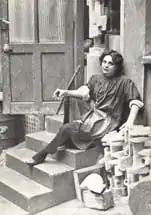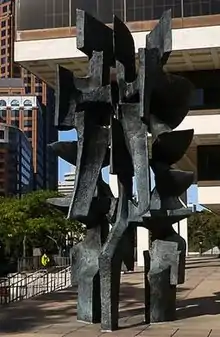Alicia Penalba
Alicia Penalba (August 9, 1918 – November 4, 1982) was an Argentine sculptor, tapestry designer, and weaver.
Alicia Penalba | |
|---|---|
 | |
| Born | August 9, 1918 San Pedro, Argentina |
| Died | November 4, 1982 (aged 69) Paris, France |
| Nationality | Argentine |
| Known for | Sculpture, tapestry, weaver |
| Movement | abstract art |

Biography
Penalba was born in San Pedro, Buenos Aires Province in 1913. She originally sought a career in drawing and painting. However, in 1950, during her stay in Paris, she decided to commit entirely to sculpture. Penalba specialized in vertical organic forms and drew inspiration from fellow sculptors Etienne Martin and Etienne Hajdu. Her works are part of the non-figurative abstract art movement and tie in with the work of Martin, Hajdu, François Stahly, Karl-Jean Longuet, Simone Boisecq and Marta Colvin who staged a renewal of the sculptural form from 1950. By the 1960s, her artwork shifted slightly toward sculptures of a more horizontal orientation. While she created many sculptures of all shapes and sizes, she is best known for her monumental pieces that can be found all over the world. Her statue, The Great Double (Le Grand Double; 1962–1964) is included in the sculpture garden of the Kröller-Müller Museum in Otterlo, Netherlands,[1] while her 1972 version is displayed outside the MGIC building in Milwaukee, Wisconsin, US.[2] She died in Paris in 1982.
Awards
- Prize, Calouste Gulbenkian Foundation, Paris, France (1974)
- Special Prize, Hakone First International Exhibition of Modern Sculpture, Ninotaira, Japan (1969)
- International Sculpture Prize, Sixth Biennial, São Paulo, Brazil (1961)
References
- "Grand double/Large double". Kröller-Müller Museum. Archived from the original on 2014-02-03. Retrieved 2014-02-01.
- Sullivan, Mary Ann. "Le Grand Double at Mortgage Guaranty Insurance Company Plaza (MGIC Plaza)".
External links
- Alicia Penalba Research
- Alicia Penalba in American public collections, on the French Sculpture Census website
- Alicia Penalba website